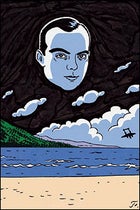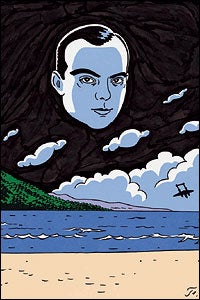EN ROUTE TO CASABLANCA, flying north across the Sahara, the plane is lost. It is an inky, moonless night in the early 1930s. The two leather-helmeted men, Antoine de Saint-Exupéry, the French pilot/poet destined to become the bard of the nascent art of aviation, and a man named Néri, his navigator, lean out of their plane and stare down at the desert, just a few hundred feet below. Through a cosmic sleight of hand, it has vanished. They peer through their goggles into a black abyss. Intermittent radio bearings from ports along the desolate Atlantic coast—Dakar, Cisneros, Agadir—have been unaccountably wrong and have pulled the aircraft far off course. The navigator has no idea where they are. The elementary control panel is of little help, although it does indicate that there is less than an hour of fuel left. Sensing that the plane is out over the ocean, rather than the desert, the pilot arcs the craft to the right.
Antoine de saint exupery

To go down in the ocean is certain, if not entirely disagreeable, death. (Drowning, Saint-Exupéry will later tell a reporter, would be his choice of endings: “You don’t feel yourself dying. You simply feel as if you’re falling asleep and beginning to dream.”) But at this point in his career, ardently in love with the adventure of flying the mail back and forth over the blazing Sahara, Saint-Exupéry is not ready for death. Better to ditch in the desert, as he has been forced to do many times before. Shipwrecked in a sea of sand, you have some chance of rescue before you either die of thirst or are captured or killed by Saharan tribesmen.
Soon they are sailing through a miasma of clouds and fog. Néri is passing notes to Saint-Exupéry. “No bearings. No bearings.” The pilot is left to navigate on passion and instinct—traits fortuitously acute in this airman. (One colleague will later say, “When the flight is normal, Saint-Exupéry is dangerous; given complications, he’s brilliant.”) These are the daring early years of aviation; one mail pilot has died almost every month. Humans have been crossing deserts by camel for millennia, sailing seas for a thousand years, climbing mountains for a hundred—the sky is the last great terra incognita for adventurers.
The wood-and-metal airplane, a French-made Latécoère 26, is plummeting through a void. Up could be halfway down or three-quarters sideways. The compass needle jerks erratically, the fuselage shudders, the wings creak. Néri has begun to pray. Saint-Exupéry steers the aircraft and dreams of the calming familiarities of earth. Laughter. A bowl of hot milk and coffee in a Moroccan café.
He has had multiple near misses, most of them in his primitive Breguet 14, a slow, ungainly biplane he flew for about a decade. It had no real nose but rather a flat forehead plugged with a giant wooden propeller. The Breguet 14’s singular redeeming attribute was a noble resoluteness founded upon mechanical simplicity. With a control panel hardly more sophisticated than that of a Ford Model T, it would still fly with a broken tail, flopping wing, or coughing engine. Saint-Exupéry, an intuitive mechanic, crash-landed the Breguet many times, repairing its Renault 300-horsepower engine with a hammer and screwdriver, and then lifting right back into the sky. (Years afterward he would elegize the obsolescence of the Breguet 14. For him, there was no charm in modern airplanes. They were soulless rockets, and flying one was a “bureaucratic affair . . . a life without surprises.”)
There was an uncanny resemblance between the pilot and his favorite airship. On the ground, in old black-and-white photos, both the Breguet 14 and Saint-Exupéry appear bulky and awkward. Saint-Exupéry was a head taller than most men, clumsy and uncomfortable in his bearlike form. (In his 1942 book Flight to Arras, a nonfiction account of the fall of France in WWII, Saint-Exupéry described his body as a “flunky” that he was required to dress, bathe, and feed. “It is in your act that you exist, not in your body.”) Unkempt, two thick fingers pinching a hand-rolled cigarette, a quizzical expression on his face, Saint-Exupéry, despite the regal name, was patently unheroic in appearance, an outsized man who might have been mistaken for a provincial baker.
But put the hulking Frenchman into the cockpit of a plane and send them into the sky together, and a transformation occurred. The wings became extensions of Saint-Exupéry’s arms, the cables became his tendons, the enormous, fallible engine his own thundering heart. Man and machine became one—a graceful, athletic, airborne organism. “The machine does not isolate man from the great problems of nature,” Saint-Exupéry wrote, “but plunges him more deeply into them.” Suddenly, in the black night sky, a pinprick of light is spotted off the nose of the plane. It must be the beacon of an airport! Néri bursts into song from sheer relief. Saint-Exupéry swings the craft toward the tiny light.
Then it vanishes.
Another diamond of light springs from the murk. Néri believes it can only be the Cisneros airport, in Spanish Sahara. He radios a request that the airport flash the light three times. The incandescent speck they are pursuing doesn’t so much as blink. Saint-Exupéry has been chasing stars. “And with that we knew ourselves to be lost in interplanetary space among a thousand inaccessible planets,” he writes in his 1939 memoir Wind, Sand and Stars, “we who sought only one veritable planet, our own, that planet on which alone we should find our familiar countryside, the houses of our friends, our treasures.”
Believing their fuel now depleted, they prepare to drop to earth, to crash into the savage Sahara. But then a radio call from their base in Toulouse, France, reaches them, providing bearings and a reprieve: “Your reserve tank bigger than standard. You have two hours’ fuel left. Proceed to Cisneros.”
Once again Saint-Exupéry escapes disaster through some ineffable alliance of luck and faith, ability and hubris. It’s the story of his life, and the reason why his death, a decade later, would haunt his readers and admirers for years.
EN ROUTE FROM LYON, in southern France, flying across the Ligurian Sea to Corsica, the plane was lost. It was a beautiful day in late July 1944, and the world was at war for the second time in as many generations. The pilot, Antoine de Saint-Exupéry, now the famous author of seven books, was returning from an unarmed, solo reconnaissance mission to the Rhôe Valley.
Patriotic to the marrow, Saint-Exupéry had, through utter force of personality, managed to inveigle himself a dangerous flying assignment for the Allies, despite the fact that he was 44 years old and showing the strains of a tumultuous life. Over the past 15 years he had survived innumerable airplane crashes, but two in particular had left lasting scars: a smashup en route to Egypt in 1935, followed by a five-day, 125-mile trek across the Libyan desert, in which he nearly died of thirst; and an accident in Guatemala that caused serious head wounds and a half-dozen broken bones. Add to these wrecks the tender disaster of a difficult marriage. Worse, the boundless wild world he had known as a mail pilot in West Africa—where survival was dependent on ingenuity, improvisation, and pluck—was gone.
Now, bent on helping liberate France at all costs, Saint-Exupéry was flying a highly sophisticated aircraft he detested and only marginally understood. The American-made Lockheed Lightning P-38’s control panel had 148 knobs and dials and was one of the fastest planes of its time. On almost every previous sortie in the P-38, he had experienced potentially fatal problems—engine failure or malfunction, a wing fire, near asphyxiation from a faulty oxygen mask. He had flown low over enemy territory and inexplicably survived. He had been pursued by enemy fighters and barely escaped. Like fuel leaking from a bullet hole in a wing tank, the good luck Saint-Exupéry had once had as a young mail pilot was dribbling away.
He took off at 8:30 a.m. from Bastia, on the northeastern coast of Corsica, due back in four hours. He didn’t return. By 2:30 he would have been out of fuel. At 3:30 he was reported missing and presumed dead.
For more than half a century, friends, family, reporters, and writers opined on how Saint-Exupéry might have died. Perhaps he experienced engine trouble and crashed in the Alps. Perhaps he was shot down over the Mediterranean. Perhaps he failed to properly use the oxygen equipment and blacked out. Even suicide was suggested, an act inconsistent with the pattern and pride of his life: Saint-Exupéry was willing to die for his country, but only at the hands of the enemy or the elements.
It is hard to imagine a more poignant and fitting way for Saint-Exupéry to have left this planet than by vanishing into oblivion. This is precisely what happens to the boy in his best-known work, The Little Prince, a slim autobiographical parable published in 1943 and since translated into 80 languages. “You understand . . . it is too far. I cannot carry this body with me,” the title character, a phantasmal spirit of adventure, says. “It is too heavy. But it will be like an old abandoned shell. There is nothing sad about old shells.” And with that, there is a “flash of yellow close to his ankle,” and the Little Prince evaporates.
Last fall, 59 years after Saint-Exupéry’s enigmatic disappearance, the wreckage of a P-38 was discovered a mile and a half off the southern coast of France near Marseille. Winched up from the mud of the Mediterranean, it was positively identified in April as Saint-Exupéry’s aircraft. The discovery placed boundaries on the mystery but did not solve it: No trace of his remains was found.
Still, the precise circumstances of Saint-Exupéry’s death are insignificant. Stacy Schiff, author of the 1994 Saint-Exupéry: A Biography, believes it could have been pilot error. “But does it really matter?” asked Schiff when I spoke to her recently, and then she answered herself: “No. All reconnaissance pilots ran huge risks. His death was a matter of probability. What is so thrilling was Saint-Exupéry’s life, a ragged, glorious series of close calls.”
BORN IN 1900 into a declining aristocratic French family, Saint-Exupéry was raised with his three sisters and one brother in a Louis XVI châeau near Lyon by a household of intelligent, tolerant women, including several aunts and a grandmother. His father died of a stroke before he was four years old, and he became deeply attached to his mother. A dreamy, artistic child, Saint-Exupéry was writing poetry and plays by six or seven, the plays often extravagantly performed with his family as the audience. He routinely wrote late at night, and would wake one of his siblings or cousins to listen to his compositions.
Saint-Exupéry took his first flight when he was 12, after hanging around the tiny Ambérieu airport, in southeastern France, for several weeks, pestering the pilots and mechanics. His mother had forbidden him to fly, but insubordination was already a well-developed aspect of his character. He got himself taken up for two short loops, and his life-long love affair began.
In 1921, he took expensive flight lessons and joined the military. He spent the better part of his two-year service flying a Breguet 14, sometimes making six flights a day. In 1926 Saint-Exupéry was hired by Aéropostale, the private French mail service. He began his apprenticeship as an airplane mechanic, was soon test-flying each new Breguet 14 the company bought, and within a year was transporting the mail from France to Spain over the Pyrenees.
For four years beginning in 1927, Saint-Exupéry flew routes over northwestern Africa, Patagonia, and the Andes. It was an emotional calling as much as a career, something that he would not experience again until World War II.
Saint-Exupéry spent most of the thirties and early forties doing more writing than flying. He covered the Spanish Civil War; wrote for magazines like Paris Soir and Harper’s Bazaar; and published books, including Night Flight, a 1931 novel about flying the night mail over South America, Wind, Sand and Stars, and The Little Prince.
After his plane was found, I was spurred to revisit The Little Prince with my two daughters. We read it together, taking chapters in turn. Teal, my nine-year-old, particularly enjoyed the miniature prince’s encounters with the inhabitants of other minuscule planets—the king, the conceited man, the lamplighter—in which the obvious allegories are outweighed by the simple, outlandish magic of the tale. Addi, a 12-year-old realist, found the whole thing a bit absurd for her tastes.
On the surface, The Little Prince is a pleasingly quirky fairy tale that reveals the obsessions of adulthood and deserves its worldwide popularity. Read with the knowledge of the author’s private anguish, it is a symbolic tale of loneliness and loss. Either way, it would be an injustice for Saint-Exupéry to be remembered solely for this one small gem.
IF YOU WANT to know who Antoine de Saint-Exupéry was, and why he should be read, you must plunge into Wind, Sand and Stars and Flight to Arras, two of the finest adventure books of the 20th century. Wind, Sand and Stars won the Grand Prix du Roman de l’Academie Française in 1939 and the National Book Award in 1940, whereas Flight to Arras was banned in his homeland for being unpatriotic. Both my copies are thumb-worn and underlined—they are dense stones in my literary foundation.
Wind, Sand and Stars is a lyrical memoir of Saint-Exupéry’s formative years of flying—his adventures winging the French mail over the Sahara, the pride of responsibility, the satisfaction of perfecting his craft, the love found among comrades sharing a cause. These same themes resound in Flight to Arras, a much darker, conspicuously spiritual book that chronicles the fall of France to the Nazis through the experiences of a French fighter pilot. Together, the two books are an homage to a life of personal integrity and action.
“The notion of looking on at life has always been hateful to me,” Saint-Exupéry writes in Flight to Arras. “What am I if I am not a participant? In order to be, I must participate.” Like Whitman, Conrad, and Hemingway, Saint-Exupéry believed that complete immersion in one’s chosen métier was fundamental, that “one needs to live in order to write. One needs to have something to say.” And then he must say it with clarity and passion.
“In anything at all, perfection is finally attained not when there is no longer anything to add, but when there is no longer anything to take away.” I’ve had this quote from Wind, Sand and Stars tacked on my office wall for 20 years.
Saint-Exupéry wrote at night and flew at night and wrote while he was flying at night. “Night, the beloved,” he rhapsodizes in Flight to Arras. “Night, when words fade and things come alive. When the destructive analysis of day is done, and all that is truly important becomes whole and sound again. When man reassembles his fragmentary self and grows with the calm of a tree.”
Yet what raises Saint-Exupéry’s work above mere adventure writing and into the realm of literature is his willingness to go beyond the vagaries of one life and openly examine the universal questions of humankind. By today’s standards, his language is unfashionably lofty and affirmative, neither reveling in minutiae nor discreetly concealing his opinion. Saint-Exupéry was not a postmodern writer. He was a thinker and a doer, a philosopher and an adventurer—as unafraid of making bold proclamations as he was of flying faulty planes over treacherous routes.
In Wind, Sand and Stars, Saint-Exupéry meditates on the meaning of his fledgling mail plane, recognizing it as evidence of a larger human impulse: “The central struggle of men has ever been to understand one another, to join together for the common weal. And it is this very thing that the machine helps them to do. It begins by annihilating time and space.” Near the end of Flight to Arras, grappling with the blight of fascism and the militarism required to fight it, Saint-Exupéry asserts, “It is easy to establish a society upon the foundation of rigid rules. It is easy to shape the kind of man who submits blindly and without protest to a master. . . . The real task is to succeed in setting man free by making him master of himself.”
Saint-Exupéry would not have been remembered as a pilot; he was just one of many valiant aviation pioneers. But it was the act of flying that set him free, and it was through the process of writing that he mastered himself. Sailing above the earth for so many years gave him an aerial perspective on the human condition, yet his writing was always more about compassion than courage, more about brotherhood than boldness. Near the end of Wind, Sand and Stars, Saint-Exupéry writes, “It is another of the miraculous things about mankind that there is no pain nor passion that does not radiate to the ends of the earth. Let a man in a garret but burn with enough intensity and he will set fire to the world.”
And he did.


